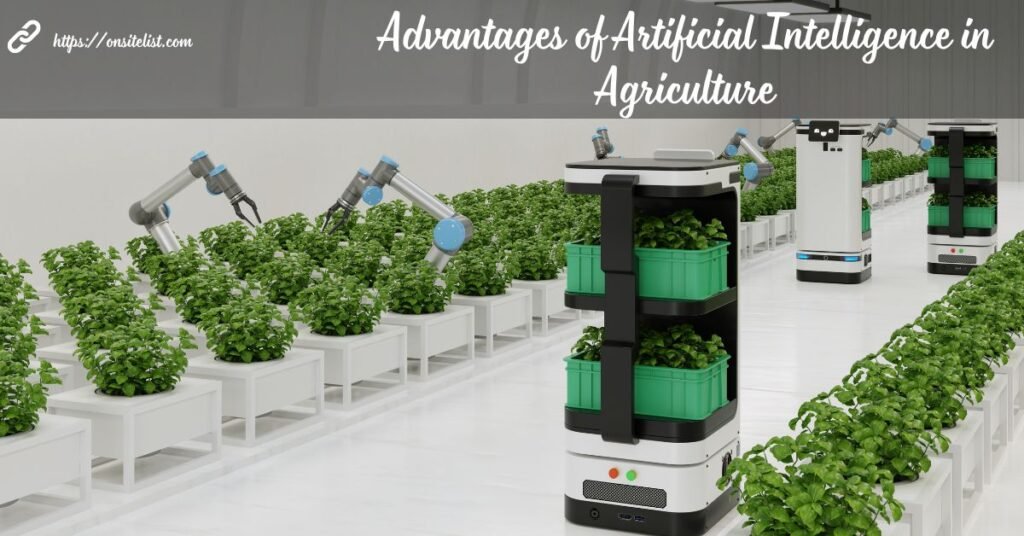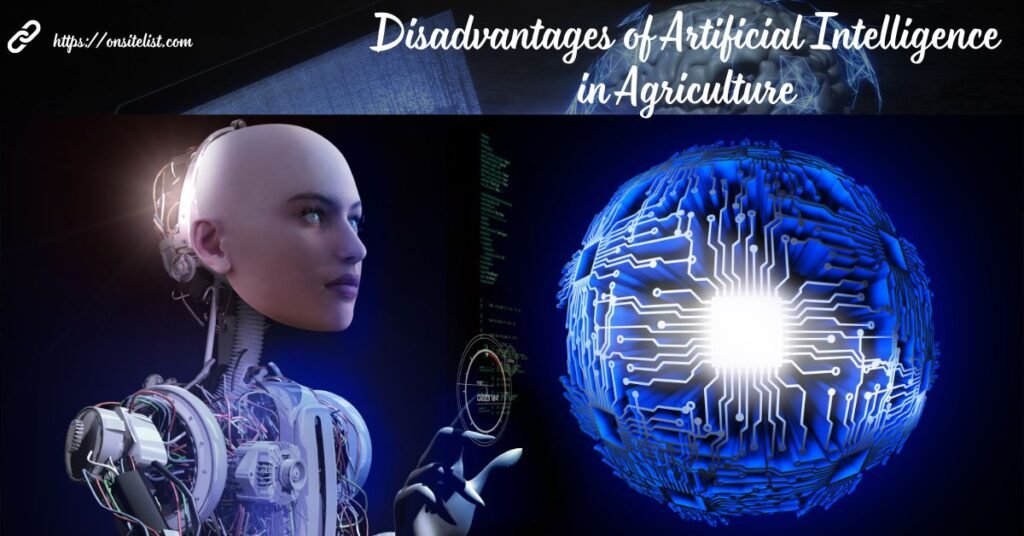Advantages and Disadvantages In Agriculture AI has ushered in a transformative era, revolutionizing traditional farming practices. The myriad advantages of AI in agriculture are evident, foremost among them being increased efficiency and productivity. Through sophisticated algorithms and data analysis, AI optimizes crop yields, minimizes resource wastage, and enhances decision-making processes for farmers.
Additionally, AI-powered systems facilitate precision farming techniques, enabling targeted interventions for pest control, irrigation, and fertilization. However, alongside these benefits, concerns regarding data privacy, technological dependency, and the digital divide persist. As agriculture continues to embrace AI, striking a balance between innovation and sustainability remains paramount for the industry’s future resilience and equitable growth.
Here’s a more detailed look at the advantages and disadvantages of AI in 2024:
Advantages of Artificial Intelligence in Agriculture

Artificial Intelligence (AI) is revolutionizing agriculture, offering solutions to increase efficiency and yields while reducing costs. By analyzing vast amounts of data, AI aids in precision farming, crop management, and predictive analytics for better decision-making. It enhances resource utilization, detects pests and diseases early, and automates labor-intensive tasks. This technological advancement is pivotal for sustainable agriculture, meeting the demands of a growing global population. AI’s role in agriculture is becoming indispensable for the future of farming.
Precision Farming and Data-Driven Decisions
Precision farming represents a transformative approach in agriculture, leveraging advanced technologies to enhance efficiency and decision-making. By integrating data analytics with farming practices, it enables farmers to optimize inputs like water and fertilizers, tailor strategies to individual field conditions, and increase crop yields while minimizing environmental impact. This data-driven methodology is pivotal for meeting the growing food demands sustainably, marking a significant shift from traditional farming methods to a more scientific, targeted management of agricultural resources. As such, precision farming is not just an innovation; it’s a necessary evolution in our quest to balance productivity with ecological stewardship.
Improved Crop Management and Yield Prediction
Improved crop management and yield prediction are at the forefront of agricultural innovation, offering a data-driven roadmap to enhance productivity. Utilizing advanced analytics and predictive models, farmers can now anticipate crop performance and manage resources more effectively. This integration of technology into agriculture not only boosts yields but also supports sustainable farming practices. By predicting environmental impacts on crop growth, these tools empower farmers to make informed decisions, ultimately leading to a more resilient food supply chain. In essence, improved crop management and yield prediction are reshaping the future of farming, one harvest at a time.
Efficient Resource Utilization
Efficient resource utilization is a strategic approach to maximizing the effectiveness of available resources. It encompasses optimizing time, budget, and personnel to achieve project goals, ensuring productivity and sustainability. This concept is integral to both economic growth and environmental conservation, as it seeks to do more with less, reducing waste and enhancing overall performance. In essence, it’s about smart management of resources for a better future.
Pest and Disease Detection and Control
Pest and disease detection and control are critical components in safeguarding crop health and ensuring agricultural productivity. Advances in technology have enabled more precise identification and management of these threats, leading to more effective interventions. This field combines traditional knowledge with modern tools, aiming to minimize crop loss and maximize yield. It’s a vital practice for maintaining the balance between food security and environmental care.
Automation of Labor-Intensive Tasks
Automation of labor-intensive tasks heralds a new era in operational efficiency, where machines and algorithms take on repetitive work. This shift not only streamlines processes but also liberates human labor for more complex and creative tasks. It’s a pivotal change that promises to reshape industries by marrying technological advancements with human ingenuity. Ultimately, it’s about enhancing productivity and fostering innovation in the workplace.
Enhanced Crop Monitoring and Remote Sensing
Enhanced crop monitoring and remote sensing technologies represent a significant advancement in agricultural science. By utilizing high-resolution satellite imagery and sophisticated data analytics, these tools provide farmers with precise information about crop health, soil moisture levels, and environmental conditions. This enables more informed decision-making, leading to improved crop yields, efficient resource use, and sustainable farming practices. The integration of these technologies is revolutionizing the way we understand and manage agricultural landscapes.
Climate-Resilient Agriculture
Climate-resilient agriculture is an innovative approach designed to increase the robustness of farming systems against the challenges posed by climate change. It integrates adaptive measures and sustainable practices to safeguard crop production, enhance soil health, and reduce vulnerability to extreme weather events. This proactive stance on agriculture ensures food security and promotes resilience in rural livelihoods, even in the face of fluctuating environmental conditions.
Disadvantages of Artificial Intelligence in Agriculture

While artificial intelligence (AI) offers numerous benefits to agriculture, it also presents certain disadvantages. The high cost of AI technologies can be prohibitive for small-scale farmers, potentially widening the gap between large and small farming operations. AI’s reliance on data may lead to privacy concerns and the risk of data breaches. Additionally, over-dependence on AI could reduce the need for human labor, leading to job losses in agricultural communities. Lastly, AI systems may not always adapt well to the unpredictable nature of farming, where human intuition and experience can be invaluable.
High Initial Investment Costs
High initial investment costs pose a significant barrier to the adoption of new technologies and business ventures. These upfront expenses can include infrastructure, equipment, training, and research and development. Such costs often deter small businesses and entrepreneurs from innovating, potentially stifling growth and competition. Moreover, the risk associated with large initial investments can lead to cautious investment strategies, slowing down the pace of technological advancement and economic expansion.
Potential Job Displacement in Agriculture
The integration of advanced technologies in agriculture has the potential to displace jobs traditionally held by humans. Automation and AI-driven tools can perform tasks more efficiently but may reduce the demand for manual labor. This shift can lead to significant job losses, particularly in regions where agriculture is a primary source of employment. The challenge lies in balancing technological progress with the socioeconomic impact on agricultural workers. Efforts to retrain and upskill the workforce are crucial to mitigate the adverse effects of job displacement.
Challenges in AI Integration with Farming Practices
The integration of Artificial Intelligence (AI) in farming practices presents a transformative potential for agriculture. However, it faces several challenges, including the high cost of smart machinery, the need for robust data to train AI models, and the resistance to technology adoption among farmers. Additionally, there’s the issue of ensuring AI decisions are explainable and the ethical considerations of job displacement. Addressing these hurdles is crucial for leveraging AI to increase efficiency and sustainability in agriculture.
Limited Access for Small-Scale Farmers
Small-scale farmers often face significant challenges due to limited access to resources, markets, and services. These constraints hinder their productivity and sustainability. Addressing these barriers is crucial for enhancing food security and promoting rural development. Efforts to improve access must be tailored to the unique needs of these farmers. Prioritizing equitable resource distribution can empower small-scale farmers and contribute to a more balanced agricultural sector.
Data Privacy and Security Risks
In the digital age, data privacy and security risks are paramount concerns. The proliferation of data breaches and cyber-attacks highlights the vulnerability of personal information. As technology advances, safeguarding data against unauthorized access becomes increasingly complex. Consumers and organizations alike must prioritize robust security measures to protect sensitive data. A proactive approach to data privacy can mitigate risks and enhance trust in digital systems.
Over-Reliance on AI Predictions
The increasing reliance on artificial intelligence for predictions in various sectors raises concerns about the potential consequences of over-dependence. While AI offers unparalleled efficiency and data processing capabilities, it also introduces risks associated with automation bias and decision-making complacency. As we integrate AI more deeply into our lives, it is crucial to maintain a balance, ensuring that human oversight and critical thinking remain integral parts of the process. This balance will help mitigate the risks while harnessing the benefits of AI’s predictive power. Ultimately, a collaborative approach between human intelligence and artificial intelligence can lead to more robust and reliable outcomes, Advantages and Disadvantages In Agriculture AI.
FAQs
Artificial Intelligence (AI) has a range of advantages and disadvantages that are important to consider:
Advantages of AI:
Reduction in Human Error: AI systems can significantly reduce errors and increase accuracy and precision.
Efficiency and Automation: AI can automate repetitive tasks, leading to increased efficiency.
Data Analysis: AI can analyze large volumes of data to make informed decisions.
Medical Advancements: AI assists in medical diagnosis and treatment plans.
24/7 Availability: Unlike humans, AI systems can work continuously without breaks.
Disadvantages of AI:
Job Displacement: AI can automate tasks previously done by humans, leading to potential job loss.
Ethical Concerns: Issues such as bias, privacy, and decision-making in AI systems can raise ethical concerns.
Security Risks: AI systems can be vulnerable to hacking and misuse.
Lack of Creativity: AI may not replicate the creative aspects of human intelligence.
High Costs: The creation and maintenance of AI systems can be expensive.
Automation-spurred Job Loss: The risk of job losses due to automation is significant.
Deepfakes and Misinformation: AI can create realistic fake content, leading to misinformation.
Privacy Violations: AI could infringe on individual privacy.
Algorithmic Bias: AI systems can inherit biases from their training data.
Socioeconomic Inequality: AI could exacerbate existing inequalities.
Uncontrollable Self-aware AI: There is a theoretical risk of AI becoming self-aware and uncontrollable, Advantages and Disadvantages In Agriculture AI.
Whether AI is good or bad for the future is a complex question. AI has the potential to bring numerous benefits, such as enhanced productivity, improved healthcare, and solving complex problems. However, it also poses risks like job displacement, ethical dilemmas, and security concerns. The outcome will largely depend on how we manage and regulate AI development. It’s crucial to balance innovation with ethical, Advantages and Disadvantages In Agriculture AI
Conclusion
The integration of AI in agriculture in 2024 offers numerous advantages and disadvantages. On the positive side, AI enhances efficiency through automated processes, increases productivity with data-driven insights, and enables precise resource management, leading to sustainable practices.
AI facilitates predictive analysis for better decision-making, optimizes crop yields, and promotes precision farming techniques, thus reducing waste and environmental impact. However, challenges persist, including the initial investment costs, concerns over data privacy and security, as well as the potential displacement of labor. Despite these drawbacks, the transformative potential of AI in agriculture remains undeniable, poised to revolutionize the industry and address pressing global food security challenges.
Thanks For Read!
Comments